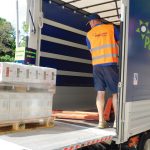A wake-up call for drivers

Even the most responsible companies, the best drivers and the most comprehensive training have not eliminated the incidence of truck accidents. FOCUS investigates how in-cab fatigue-detection technology is providing a wake-up call for drivers.
Research conducted by the Interdisciplinary Accident Research Centre in South Africa suggests that up to 41 percent of road accidents can be attributed to fatigue. Senior client manager of DriveRisk, Gerard Kloppers, says: “Driver fatigue and distraction are two of the most pervasive challenges facing logistics operators worldwide.
“Research suggests that crashes where driver fatigue is a factor tend to be of a higher severity and often include fatalities. This is because by the time the driver is woken by being jolted around the cab it’s normally too late to apply the brakes.”
Dangerous behaviour, habits and lifestyle
Kloppers explains that fatigue can be caused by a variety of factors and doesn’t happen in just one day. The cumulative effect of not getting enough sleep is referred to as sleep debt or sleep deficit.
Basically, if a driver gets less than five hours of sleep over an extended period of time, the hours lost begin to add up and must be made up. In other words, one good night of sleep may not necessarily be sufficient.
“Bad habits are developed over a period of time. Tiredness might be brought on by family challenges, stress at work, time constraints, not eating correctly or not sleeping enough,” says Kloppers.
The nature of the industry means that drivers are constantly pushed for time, and this can contribute to bad diet and lack of sleep. To make matters worse, many drivers are required to sleep in the cab at noisy truck stops where their sleep is often interrupted.
Kloppers says: “Pressure from management as a result of understaffing, or undue pressure to reach a destination, remain a problem. Poor lifestyle choices could result in the development of non-communicable diseases, such as heart disease and diabetes, of which fatigue is a side-effect.”
The loneliness of the job means that some drivers seek out excitement in bars, while others prefer to spend their time with prostitutes, putting themselves at risk of contracting HIV and other diseases.
There are times, however, where a driver and the transporter have done everything right and yet the driver still falls asleep. This illustrates the complexity of dealing with fatigue. The monotony of the job certainly is a factor to be considered.
Kloppers says: “We have found that this is especially true for drivers working on the mines. These drivers travel the same road at low speed, many times each day. The same applies to long-haul operators that travel on long, straight roads with few landmarks.”

Fatigue detection
Fatigue-detection technology uses infrared technology to monitor movement of the eye and posture of the body. Because the system is able to detect how long a driver’s eyes are away from the road, it is useful in the detection of both driver fatigue and driver distraction.
Kloppers says: “Percentage of eye-closure technology (Perclose) allows the transporter to apply a proactive approach to the prevention of crashes caused by fatigue. It is possible to see when someone is falling asleep and identify distractions, such as eating or using a mobile phone.”
“Notifications or warnings coming from DriveRisk’s DriveAlert system come in three stages. First, an alarm inside the cab will sound if there is too much body movement, or if the driver’s eyes are away from the road for too long.
“If the driver does not respond within seconds, there will be a second, more forceful alert.
“Third, when no response has been elicited, the system will stream live video feed to the DriveRisk control centre for viewing and assessment. From there the operators are able to identify the problem and relay this information directly to the fleet manager,” explains Kloppers.
Different types of fatigue
Kloppers says that the DriveRisk control centre uses the information received to categorise different types of fatigue.
“Critical fatigue, also referred to as micro-sleep, is probably something all of us have experienced at some point,” says Kloppers. This is where a person’s eyes close for a few seconds before he or she wakes disorientated and in a state of confusion.
“The identifiers of possible fatigue enable transporters to respond before ‘the nod’ occurs. Here, we look at body language, but also what the driver is doing inside the cab. Sitting too close to the steering wheel, or shuffling around in the seat are common indicators of possible fatigue.
“Other signs of possible fatigue may include things like yawning, stretching, rubbing of the forehead or wiping of the eyes. Many of the companies we work with choose to intervene immediately by advising the driver to pull over to rest at this point,” asserts Kloppers.
Urban myths
Kloppers confirms the commonly held view that road accidents often happen close to home. “Drivers start to unwind and ready themselves for rest the closer they are to their destination. Alternatively, the thought of reaching their destination causes some to push ahead despite feeling fatigued,” says Kloppers.
When feeling tired, some suggest opening windows on the cab, or turning up the volume on the radio. Others suggest making a brief stop, getting out of the vehicle and jumping around for a bit.
Kloppers points out that that many drivers use energy drinks in an attempt to keep themselves alert. “Unfortunately, this provides only a temporary boost before energy levels drop below what they were to start with. People often believe that certain actions will help to keep them awake when really the only thing to do is to stop and rest.”
Driver training
As is the case with telematics, the information received at control centres is used to improve driver behaviour and the business. Kloppers says: “Clients are alerted about critical events, if and when they occur. We also provide clients with a weekly incident report that lists the behaviours that have been identified.”
It is possible to identify individual trends, make deductions and implement strategies to address these. If one driver is struggling with a particular shift or route, the fleet manager could swap this with another driver. The system can also show if a driver is being distracted by a mobile phone. The company could then perhaps implement a policy requiring mobile phones to be locked up while driving.
Fatigue can make it difficult for drivers to react to things that happen around them and has been compared with driving while under the influence of alcohol. Fatigue-detection technology saves lives, but it also has the capacity to reduce accidents and pay for itself with money saved on premiums.
“Our goal is to identify, coach, improve and mitigate risk, while ensuring that drivers get home safely,” concludes Kloppers.
Published by
Focus on Transport
focusmagsa




